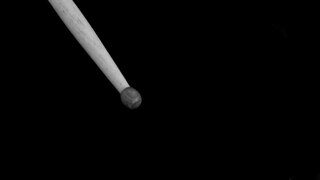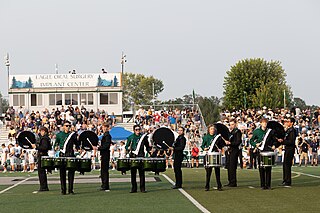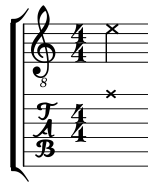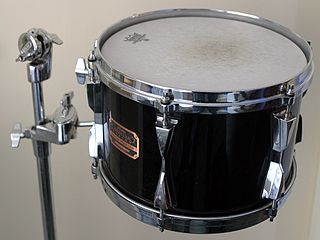
The drum is a member of the percussion group of musical instruments. In the Hornbostel-Sachs classification system, it is a membranophone. Drums consist of at least one membrane, called a drumhead or drum skin, that is stretched over a shell and struck, either directly with the player's hands, or with a percussion mallet, to produce sound. There is usually a resonant head on the underside of the drum. Other techniques have been used to cause drums to make sound, such as the thumb roll. Drums are the world's oldest and most ubiquitous musical instruments, and the basic design has remained virtually unchanged for thousands of years.

A drum kit is a collection of drums, cymbals, and sometimes other auxiliary percussion instruments set up to be played by one person. The drummer typically holds a pair of matching drumsticks, and uses their feet to operate hi-hat and bass drum pedals.

A percussion instrument is a musical instrument that is sounded by being struck or scraped by a beater including attached or enclosed beaters or rattles struck, scraped or rubbed by hand or struck against another similar instrument. Excluding zoomusicological instruments and the human voice, the percussion family is believed to include the oldest musical instruments. In spite of being a very common term to designate instruments, and to relate them to their players, the percussionists, percussion is not a systematic classificatory category of instruments, as described by the scientific field of organology. It is shown below that percussion instruments may belong to the organological classes of idiophone, membranophone, aerophone and cordophone.

The snare drum is a percussion instrument that produces a sharp staccato sound when the head is struck with a drum stick, due to the use of a series of stiff wires held under tension against the lower skin. Snare drums are often used in orchestras, concert bands, marching bands, parades, drumlines, drum corps, and more. It is one of the central pieces in a drum set, a collection of percussion instruments designed to be played by a seated drummer and used in many genres of music. Because basic rhythms are very easy to learn to play on a snare drum even for children, the instrument is also suitable for the music education for young children and a rhythm band.

The bass drum is a large drum that produces a note of low definite or indefinite pitch. The instrument is typically cylindrical, with the drum's diameter much greater than the drum's depth, with a struck head at both ends of the cylinder. The heads may be made of calfskin or plastic and there is normally a means of adjusting the tension either by threaded taps or by strings. Bass drums are built in a variety of sizes, but size does not dictate the volume produced by the drum. The pitch and the sound can vary much with different sizes, but the size is also chosen based on convenience and aesthetics. Bass drums are percussion instruments and vary in size and are used in several musical genres. Three major types of bass drums can be distinguished.
A blast beat is a type of drum beat that originated in hardcore punk and grindcore, and is often associated with certain styles of extreme metal, namely black metal and death metal, and occasionally in metalcore. In Adam MacGregor's definition, "the blast-beat generally comprises a repeated, sixteenth-note figure played at a very fast tempo, and divided uniformly among the bass drum, snare, and ride, crash, or hi-hat cymbal." Blast beats have been described by PopMatters contributor Whitney Strub as, "maniacal percussive explosions, less about rhythm per se than sheer sonic violence".
"The 'original' or traditional blastbeat is a single-stroke roll played between your cymbal and snare, with your kick playing simultaneously with every cymbal hit."

A floor tom or low tom is a double-headed tom-tom drum which usually stands on the floor on three legs. However, they can also be attached to a cymbal stand with a drum clamp, or supported by a rim mount. It is a cylindrical drum without snare wires, and tend to produce a booming, resonant sound which can vary in pitch.

A drum roll is a technique used by percussionists to produce a sustained sound for the duration of a written note.
All drum figures are based upon three fundamental beats, technically called roll, single stroke, and flam...Sustentation is accomplished upon wind instruments by blowing into the instrument; it is accomplished upon the violin and the allied instruments by drawing the bow across the string; it is accomplished upon the drum and allied percussion instruments by the roll.
THE SNARE DRUM ROLL.
The roll consists of an even reiteration of beats sufficiently rapid to prohibit rhythmic analysis. To produce an impression of sustentation, these beats must be absolutely even both in power and in sequence. Uneven beats in a roll destroy the impression of sustentation. Evenness is then the primary quality to strive for in roll; speed is the secondary quality to strive for.
There are two possible ways of producing an absolutely even sequence: (1) hand alternation of single stroke and (2) hand alternation of double strokes...The snare drum roll is produced by hand alternation of double strokes.
The "open roll" is produced by [initially] slow hand alternation. Two strokes in each hand alternately are produced by wrist movement and each beat should follow its predecessor in clock-like precision.
In music, a drone is a harmonic or monophonic effect or accompaniment where a note or chord is continuously sounded throughout most or all of a piece. A drone may also be any part of a musical instrument used to produce this effect; an archaic term for this is burden such as a "drone [pipe] of a bagpipe", the pedal point in an organ, or the lowest course of a lute. Α burden is also part of a song that is repeated at the end of each stanza, such as the chorus or refrain.

Marching percussion instruments are percussion instruments specially designed to be played while moving. This is achieved by attaching the drum(s) to a special harness worn by the drummer, although not all marching bands use such harnesses and instead use traditional baldrics to sling their drums.
In music, a breakdown is a part of a song in which various instruments have solo parts (breaks). This may take the form of all instruments playing the verse together, and then several or all instruments individually repeating the verse as solo parts.
A tenor drum is a membranophone without a snare. There are several types of tenor drums.
Orchestral percussion refers to the various percussion instruments used in an orchestral setting. It may also refer to the act of playing such instruments in an orchestral style. Many music schools and conservatories offer training for musicians interested in developing their skills as orchestral percussionists. Typically, an orchestral percussionist does not specialize in one particular instrument. Although there is no exhaustive list of all instruments that an orchestral percussionist must be able to play, there are particular instruments that are frequently used in the orchestral repertoire. This includes timpani, snare drum, bass drum, xylophone, glockenspiel, triangle, and tambourine.

Drum hardware is the set of parts of a drum or drum kit that are used to tension, position, and otherwise support the instruments themselves.

In music, notably in jazz, a ghost note is a musical note with a rhythmic value, but no discernible pitch when played. In musical notation, this is represented by an "X" for a note head instead of an oval, or parentheses around the note head. It should not be confused with the X-shaped notation that raises a note to a double sharp.

A tom drum is a cylindrical drum with no snares, named from the Anglo-Indian and Sinhala language. It was added to the drum kit in the early part of the 20th century. Most toms range in size between 6 and 20 inches in diameter, though floor toms can go as large as 24 inches (61 cm).

This is a glossary of jazz and popular music terms that are likely to be encountered in printed popular music songbooks, fake books and vocal scores, big band scores, jazz, and rock concert reviews, and album liner notes. This glossary includes terms for musical instruments, playing or singing techniques, amplifiers, effects units, sound reinforcement equipment, and recording gear and techniques which are widely used in jazz and popular music. Most of the terms are in English, but in some cases, terms from other languages are encountered.

The Scottish tenor drum is a musical instrument used within Scottish pipe bands. It is a double-headed membranophone that is held vertically with one head up, one head down, and played with soft mallets on the top head only. Common sizes of drums are 15, 16, 18, or 20 inch in diameter, with 12, 14, or 16 inch depth. The playing style of the Scottish tenor drum has varied throughout the years, but there is typically a variation of the combination of swings and rhythmic accompaniment to the Scottish snare drum and the Great Highland Bagpipes. It is similar to the more common marching band style tenor drum.

An unpitched percussion instrument is a percussion instrument played in such a way as to produce sounds of indeterminate pitch, or an instrument normally played in this fashion.

Heavy metal drumming is a style of rock music drum kit playing that developed in the late 1960s and early 1970s, largely in the United States and the United Kingdom. With roots in blues rock and psychedelic/acid rock drum playing, heavy metal drummers play with emphatic beats, and overall loudness using an aggressive performing style. Heavy metal drumming is traditionally characterized by emphatic rhythms and dense bass guitar-and-drum sound.
![]() = 75 bpm.
= 75 bpm.













